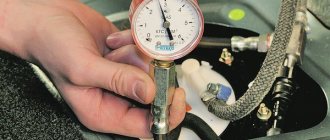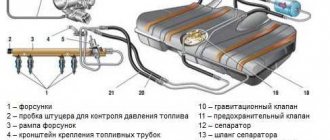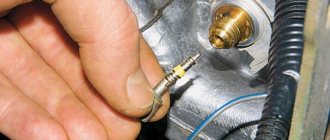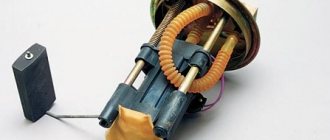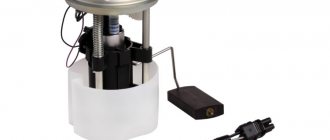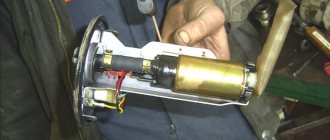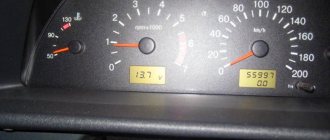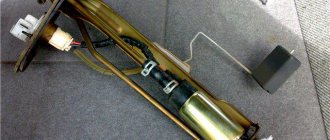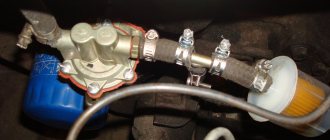For proper and reliable operation of the VAZ 2110 engine, optimal fuel pressure must be maintained in it, and deviations in pressure seriously affect the operation of the entire engine.
Sometimes when a car starts poorly, jerks, or refuses to drive at all, one of the reasons for such malfunctions may be insufficient fuel pressure in the system.
In this article, we will look at ways to check the fuel pressure in the VAZ 2110 ramp, and we will also talk about the nominal pressure in the fuel system and much more.
Fuel pressure in the system
Fuel pressure is one of the important parameters in the car system; the reliability of starting and driving the car depends on it. The pressure is pumped up by a special fuel pump (gasoline pump), which pumps fuel into the rail, and a special fuel pressure regulator dumps excess fuel back into the tank, thereby regulating it.
Parts affecting fuel pressure:
- Fuel pump;
- RTD;
- Filter;
- Injectors;
These parts, if they fail, can reduce fuel pressure.
Signs of breakdown
If for some reason the fuel pressure regulator does not perform its functions, then this can be understood by the following signs:
- The engine's operation has become unstable, it may begin to stall when idling, although it would seem that the fuel level is sufficient and all systems are in working order;
- The crankshaft at idle speed has increased or, conversely, decreased speed;
- The engine, as they say, “loses throttle response”;
- While driving, dips and jerks occur in a running engine;
- Gasoline consumption increases compared to what it was before;
- The content of CO and CH in the exhaust increases;
- The engine starts with difficulty. Although this property does not always appear.
If the regulator has become completely unusable, then an increase in fuel pressure is observed. Instead of the norm for the VAZ 2110, which ranges from 2.5 to 3.3 kg/cm2, it reaches 4 – 5 and even more.
Consequently, the fuel pump supplies more gasoline by volume, which is not completely burned, and overconsumption is guaranteed. Of course, such a regulator needs replacement, and the sooner the better.
If the fuel pressure regulator does not provide the required pressure, or simply does not hold, then the lack of fuel pressure leads to the fact that normal supply does not occur, and the VAZ 2110 “chokes” when you need to increase the speed.
In addition, the starter cannot quickly spin the engine; it has to be turned on many times.
What is the pressure in the fuel system of the VAZ 2110
As you know, the VAZ 2110 was equipped with three types of engines: 8-valve carburetor, 8-valve injection, 16-valve injection. Each of these engines has its own pressure readings, except for the carburetor engine, its fuel is not supplied under pressure.
An 8- and 16-valve injection engine, with an aluminum receiver, that is, with a return line, has a fuel pressure of 2.8-3.2 bar.
A 16-valve engine (124) with a plastic receiver, has no return, the fuel pressure in it is 3.6-4.0 bar.
ON-BOARD DIAGNOSTICS FOR FAULT DETECTION
A malfunction of the fuel system leads to a deviation in pressure in the fuel rail. As a result, the amount of fuel supplied to the cylinders differs from the calculated one, and the air-fuel mixture becomes depleted or enriched. In engine management systems with an oxygen sensor, the controller monitors the current composition of the air-fuel mixture.
If the air-fuel mixture deviates significantly from the desired value, the controller perceives this condition as a malfunction, and one of two fault codes is recorded in the controller’s memory:
- P0171 - fuel system too lean;
- P0172 - fuel system too rich.
Increased or decreased pressure in the fuel rail is just one of the reasons why codes P0171, P0172 can be recorded in the controller’s memory. The cause of a significant depletion or enrichment of the air-fuel mixture may be faulty mass air flow sensors, oxygen sensors, or injectors. Air leaks lead to an over-lean air-fuel mixture.
The fuel pressure value may be outside the permissible range, but the on-board diagnostics does not record anything. It’s a very real situation - on-board diagnostics are not omnipotent.
If you find an error, please select a piece of text and press Ctrl+Enter.
1) Good day! I encountered a problem with excess pressure in the GAS TANK. I noticed this phenomenon when opening the tank lid, and a hissing sound was heard. It is excess air, and not a vacuum, that causes the air to escape and cause the smell of gasoline to be felt. Car VAZ 2114 11th year. There is a EURO-3 adsorber, the adsorber purge valve is located on the receiver. Has anyone encountered this problem? Is there a two-way valve in this system? Can it affect the presence of excess air? Is it located? Could the problem be in the gravity valve? Or is the problem in the adsorber itself? The CHECK does not light up and did not light up. Hello, help me with one question, in general I decided to put music in the 2106 Pioneer radio and two speakers on the shelf, so I wanted to install an amplifier and I don’t know which one to get, 2-channel or 4-channel xs and is it worth installing? number of the question you are answering!. Excessive pressure in the gas tank injector VAZ 2110.
Checking fuel pressure
To check, you need to prepare a special tool, a pressure gauge for measuring air or liquid pressure; connect a hose with a diameter of 12 mm to the pressure gauge through a clamp.
It is advisable to cover the generator with a rag so that fuel does not get on it.
The process of measuring fuel pressure:
- We relieve the fuel pressure by removing the connector from the fuel pump in the system and starting the engine, letting it run until it stops.
- We unscrew the fuel rail cap near the timing belt drive.
- We unscrew the spool.
- We connect the pressure gauge to the fuel rail and tighten it with a clamp.
- Turn on the ignition to activate the fuel pump.
- We check the pressure on the pressure gauge and compare them with the nominal readings.
Increased pressure in the fuel tank Kalina
Hi all!
A little background. At the end of summer, I began to notice that the car periodically jerks when accelerating sharply, and my agility has diminished... For about a month I gathered my thoughts to assemble a pressure gauge for the fuel system) During this month, I checked the tightness of the injectors in the following way: - We pull out the ramp with the injectors; — We pump up the pressure in the fuel line by turning the ignition on and off several times; — We monitor the nozzles so that nothing drips or oozes anywhere.
Result:
All injectors are dry and hold pressure.
Then the time came to change the oil and filters (oil, air and fuel), but there were no changes in engine performance.
Finally, I collected my thoughts and found a suitable pressure gauge with a scale of up to 0.6 MPa ~ 6 atm. In the garage I found a piece of hose of suitable diameter (about a meter) and a couple of tape clamps.
Pressure gauge with hose
First I decided to measure the pressure on the ramp: 1. Remove the protective cap; 2. We press on the nipple to release the pressure (gasoline will flow out), I put a rag under the nipple so that gasoline does not flow onto the exhaust manifold; 3. Unscrew the nipple; 4. Connect the hose with the pressure gauge and tighten the clamp; 5. First, I checked the pressure created by the pump when the ignition is turned on; 6. Then we start the engine and check the pressure in different modes (speeds) - here it turned out that it was not in vain that we took a long hose =) I secured it under the wiper and watched the readings from inside the car;
The result is not reassuring:
1. When the ignition was turned on, the pump somehow pumped up 1 atm, after 3 times the ignition was turned on, only 2.5 atm was pumped up; 2. At XX the pressure is 3.2 atm, which doesn’t seem bad; 3. When adding gas, the pressure drops to 2.5 atm.
I decided to check the pressure on the pump itself (without the return line): 1. Recline the rear seat; 2. Unscrew the 4 screws of the fuel pump module hatch; 3. You need to remove the hose from the fuel pump on the right (if you look in the direction the car is moving), but carefully, if there is pressure left, gasoline will spray out; 4. Connect the pressure gauge hose and tighten the clamp; 5. First I checked in the same way as with the ramp - turned on the ignition; 6. Connected the ELM adapter and, using the OpenDiag program on the smartphone, forcibly turned on the fuel pump for 10 seconds;
This is how the pressure gauge is connected to the fuel pump module
The result is almost the same:
1. From ignition, only about 1 atm was pumped; 2. After 10 seconds of pump operation, the pressure rose to 2.5 atm, but did not rise higher.
To be completely sure, I decided to remove the fuel pump module and check everything inside.
There is dirt inside the glass
The mesh is also not the first freshness, although it was changed about 18,000 km ago
There were posts on the Internet that the tube from the pump was fraying; mine was slightly frayed in one place, but it was still very far from being completely frayed.
Old pump. Czech.
Czech
At the same time, I checked the RTD (Fuel Pressure Regulator): 1. Connected the compressor to the fitting on the left (see photo with the pressure gauge connected to the pump); 2. Turned on the compressor and monitored the pressure.
Result:
At least everything is clear here =) it works exactly at 3.8 atm.
After all the checks, I did not put the pump back, but replaced it anyway. I went shopping in search of a pump and corrugated tubes for it. I found several options: Bosch (like Germany) - 2800 rubles. ATS (Germany (China)) - 770 rub. no name Russian production - 780 rub.
Take Bosch - the toad crushed him. The choice was between a Chinese and a Russian pump. According to the seller, at the neighboring service station they often take ATS and do not complain. I decided to take a risk and took the ATS for 770 rubles. + two corrugated tubes for 40 rubles.
Pump box. It says 3 bar.
Corrugated tubes.
Having read on the Internet about the technology of stretching corrugated tubes, I took the pump home to do everything in a warm place. Some people advise heating the pipe in water, others on an open fire, and others with an industrial hair dryer. Because I don’t have a hairdryer, so I decided to try the water method: 1. Bring water to a boil; 2. Dip part of the tube into boiling water (I kept it for about a minute); 3. Try to tighten the fuel pump or the fuel pump module cover.
As a result, in this way it was possible to pull the tube only onto the pump itself. The tube did not want to fit onto the lid beyond the first ledge... Either the fingers slipped, or the tube quickly cooled down.
Pipe on the pump. Well, the inscription
I decided to try the method of heating over a fire (gas stove burner): 1. First, I slightly heated the tip to understand how the tube heated over a fire behaves; 2. Heated it up a little more and pulled it onto the lid fitting the first time.
The fire method is good, but you have to be careful. The end of my tube was slightly melted.
Tube on the lid
Well, as a final touch, I secured the tube with two clamps, just to be sure =)
How to eliminate the smell of gasoline in the interior of a VAZ-2107 (injector): tips
VAZ-2107 is the latest classic Zhiguli model. The “Seven” of recent years of production was characterized not only by an updated engine, but also by a new power system. The VAZ-2107 is the only classic that could have an injector installed from the factory. But even after such changes, owners complain about the smell of gasoline in the cabin. On a VAZ-2107 (injector) it can appear for various reasons. This is not always a technical failure. Read more about this problem, as well as how to eliminate the smell of gasoline in the cabin on a VAZ-2107 (injector) further in the article.
Fuel system features
"Seven" is an improved version of "Six". The latter, in turn, like all its predecessors, was distinguished by a carburetor power system. On the VAZ-2107 an injector can be used to supply the combustible mixture.
This system is more reliable and efficient. The use of an injection power system on the VAZ-2107 made it possible to increase power by 5 percent and reduce fuel consumption by 7 percent. An injection system is a whole complex of parts that combines the following elements:
A more detailed diagram of the VAZ-2107 fuel system (injector) is presented below.
How it works? Fuel is supplied to the injectors under pressure. It is much higher than that of carburetor cars, but it is pumped not by a mechanical, but by an electric pump. On injection “Sevens”, a submersible pump is installed directly into the tank. On carburetor engines it is mechanical and is located in the engine compartment. Because of this, he often overheated on hot days. A submersible pump pumps fuel out of the tank, where it enters the intake manifold through tubes under a pressure of 3 - 3.5 atmospheres. Gasoline first undergoes a purification procedure. For this purpose, a fine and coarse filter is provided (the latter is located directly in front of the pump). The amount of fuel that enters the cylinders is dosed by the injectors themselves using electronics. Excess gasoline flows through the fuel check valve into the tank. This element is two-way. It is indicated by the number 10 on the diagram of the VAZ-2107 fuel system (injector), which is presented above.
All processes for supplying and preparing the gasoline mixture occur automatically. As reviews note, the system is quite reliable and does not require adjustments, as is the case with a carburetor. But sometimes problems can arise with it. For example, the smell of gasoline suddenly appears in the interior of a VAZ-2107 (injector). What to do and why it is dangerous, we will consider further.
What are the consequences
There should be no foreign odors, including fuel, in the interior of a serviceable car. If the inside smells like gasoline, there is a leak in the system. This is the direct cause of unauthorized fire, which is very dangerous.
It is also worth remembering that gasoline vapors are very toxic to the human body. The driver and passengers will feel dizzy, lethargic and even nauseous. Therefore, you should not hesitate to solve this problem.
Checking the tank cap
It's not the fuel filler neck. Even when it is opened, the smell of gasoline will not seep into the cabin. The reason must be sought in the tank itself. The injection “Seven” has a slightly different design. If on carburetor cars it is solid, then here it has a hole for the pump. The lid is closed with bolts evenly around the perimeter. Perhaps due to loose fastenings, vapors begin to leak out.
Where is the tank?
On most passenger cars it is located under the rear seat cushion. But on classic Zhiguli cars it is located on the right side in the trunk (VAZ-2107 is no exception). It is easy to detect - this element is not hidden by any casing or casing.
Damage diagnostics
How to understand that an injector needs to be replaced, checked or repaired? Even without sensors, you can understand that repair of fuel system elements is required if there are 1 of 2 main signs in models 2107, 21074:
The cause of such failures is clogged injectors; even diagnostics are not needed. Cleaning helps restore the engine to its original performance. If the problem has not been resolved after cleaning, it is worth checking the tubes and injectors for damage or breakdowns. In such cases, it is better not to start repairs, but simply replace the damaged parts with new ones.
Sometimes it is impossible to determine on your own where the damage is, and only then will diagnostics at service centers come in handy. A blockage can cause quite serious damage to the VAZ 2107 injector, as well as rupture of channels. The pressure that arises inside the system can easily destroy the most fragile parts. Here you won’t be able to fix the situation with your own hands, even if you have a complete diagram of the car at hand. There is only one conclusion - you need to devote a lot of time and attention to cleaning injectors and do it regularly.
Causes of fuel pump failure on a VAZ-2110
Contamination of the fuel tank leads to premature failure of the fuel pump.
The main reason that can lead to failure of the fuel pump is poor fuel and a constant low amount of fuel in the tank (5 liters or less).
Incorrect operation of the unit can also lead to unit malfunction. Experts advise that when starting the engine, initially turn on only the ignition for 2-3 minutes and do not turn on the starter. During this time, the pump will pump the required amount of fuel into the system and create a certain pressure there.
The pump may also fail due to natural wear and tear . It usually lasts for a mileage of 150,000 kilometers . This is 4-5 years. But the timing may be different. It all depends on the conditions of its operation.
Burnt contacts of the fuel pump terminal block.
Sometimes a pump failure can be caused by a breakdown in the electrical network, failure of a relay or fuse. Such malfunctions can be quickly eliminated on your own. It's not expensive.
There are craftsmen!
Important! The fuel supply pump can be repaired. This procedure will cost less than buying a new pump. But it’s not worth it (editor’s opinion).
Communities => Auto => Topic started by: tigrok from 16 September 2014, 18:22:22
| Name: gas tank Lada Kalina Posted by: tigrok on September 16, 2014, 6:22:22 pm |
Well, if the air comes out and the check does not light up, then everything is in order.
But if it is sucked in, then there should be a valve on the four next to the filler neck, it needs to be checked. Quote from ZR. “Question: On a VAZ-21093 car (injection, neutralizer), after the engine is running, opening the gas tank cap is accompanied by a hissing sound. Answer: Most likely, your car is equipped with an EVAP (gasoline vapor recovery system). In this case, the fuel tank communicates with the atmosphere through an adsorber (installed in the engine compartment), which prevents gasoline vapors from entering the atmosphere. The pressure in the fuel tank may be slightly elevated. The reason is an increase in the temperature of gasoline in the tank when excess heated fuel from the ramp enters it through the drain line (return). The gas tank valve (located in the engine compartment in front of the canister) releases fuel vapor from the tank into the canister at a pressure slightly greater than atmospheric pressure. Therefore, a slight hiss of air coming out of the tank when the cap is unscrewed is possible - this is not considered a malfunction. This may be indicated by something else: when the cap is opened, air is drawn into the tank. This happens when the fuel tank ventilation hose is pinched or when the gravity valve that prevents fuel leakage is installed incorrectly if the car rolls over (the valve is turned 180 degrees or installed obliquely, whereas it should be strictly vertical). In addition, there are cases when some “craftsmen” independently “upgrade” the ventilation system of the fuel tank - they plug the air pipe with the inscription “air” on the canister cover with a plug or completely dismantle the adsorber and “jam” the ventilation hose suitable for it. In both cases, when the engine is running, a vacuum is formed in the tank.”
Injection system on Kalina
The system that serves in the Kalina car to capture fuel vapors prevents their unplanned leakage into the atmosphere. These vapors are formed due to heating of the fuel in the gas tank, as well as when atmospheric pressure decreases. The vapors do not escape, but accumulate in the system; when the engine starts, they enter the intake manifold and burn in the power unit. To regulate the flow of fuel evaporation from the adsorber into the intake manifold receiver, the Kalina adsorber purge valve is used. This valve is installed on all cars with an injection-type engine. Its location is usually under the hood.
The system includes a special adsorbing mechanism consisting of technical activated carbon, a special valve with an electric-magnetic pulse and functional pipelines suitable for it.
The entire system is based on a so-called adsorber, which is capable of collecting all the fumes from the gas tank. Small granules of technical activated carbon, which are part of the absorbent part, absorb gasoline vapors and retain them inside.
FLS
It is quite clear that we first learn about excessive consumption of gasoline by readings from the level sensor. However, sometimes the FLS also starts to lie, and then the true consumption cannot be known.
There may be a situation when you still have half a tank of gasoline, but the FLS says that the fuel is almost empty. That is, the flow sensor itself may confuse you, and before rushing to replace the regulator, make sure that the FLS is working properly, remember that the VAZ 2110 has problems with it very often.
If you notice that it is lying, the fuel sensor may need adjustment or even replacement.
Pump replacement
Here you will need to initially buy a high-quality pump. It is recommended to buy one that was previously installed . You can also buy a part from BOSH.
You will need:
- The key is "17".
- Head at "10".
- Screwdriver.
- Pliers.
Before carrying out work to remove the pump, it is worth reducing the pressure in the system and disconnecting the battery. Next, you will need to remove all the pipes that fit the pump and unscrew the bolts securing it to the motor.
The work should be carried out carefully, as a certain amount of fuel may remain in the system.
Remove the gas tank flap under the rear seat.
Disconnect the block and fuel hoses.
Unscrew the pump mounting nuts.
After removing the pressure ring, pull out the fuel pump.
Assembly work is carried out in reverse order.
